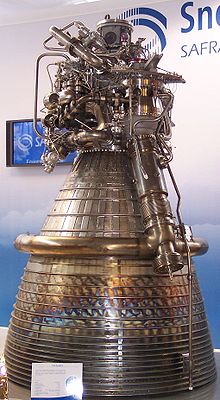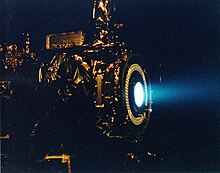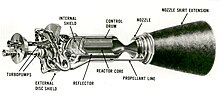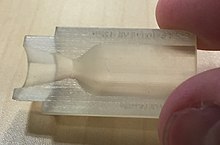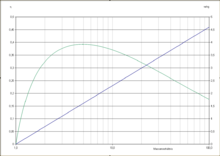Rocket engine
Rocket engines or rocket motors are drives that generate the drive force ( thrust ) by ejecting support mass against the drive direction. Because they do not suck in any material from the outside and eject it again at a faster rate, they function independently of the environment, i.e. also in a vacuum . They were originally developed for the flight of missiles .
The work of the rocket engine is based on the recoil principle (see also recoil drive ) within the framework of Newton's third axiom . The higher the speed of the ejected support mass, the more efficient the engine and the greater the possible change in speed " Delta v " of the rocket. Rocket engines are not only used to drive rockets, launch vehicles and spacecraft , but also for aircraft and special land vehicles (e.g. rocket cars ). Rocket engines are widespread in the military sector, where they are used to drive ballistic missiles or reactive projectiles (such as rocket launchers ) or to drive reactive torpedoes .
There are various designs of rocket engines and numerous efforts to reduce the resources required for rocket engines (see Aerospike ).
Theoretical effects that can be recorded in a rocket drive were presented in 1903 by Konstantin Ziolkowski using the basic rocket equation . Hermann Oberth later came to the same conclusions independently of this.
technology
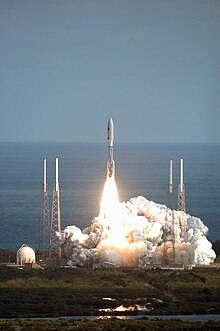
Most (but not all) rocket propulsion systems are internal combustion engines : By burning a fuel with oxidizing agents, they heat a supporting mass (usually the combustion products) in a combustion chamber at a very high temperature and allow the high-energy product of the process to escape in gaseous form through an opening. The thermal energy released during combustion and the pressure in the combustion chamber are converted into kinetic energy when it escapes and thus generate the thrust according to the recoil principle. The specially shaped outlet opening of the combustion chamber is called a nozzle , it is used to increase the outlet speed (results in higher thrust) and to increase the internal pressure in the combustion chamber (in favor of the combustion process). A frequently used type of nozzle is the Laval nozzle . The nozzle has to be cooled, which is achieved either by coatings or by internal cooling lines through which the fuel flows. Ideally, one relaxes the jet to the ambient pressure; In a vacuum or for practical reasons (length and weight) this is not possible, the design of the nozzle is therefore a compromise and part of the drive design.
A key parameter of rocket engines is the specific momentum , which describes the efficiency of the propulsion system as the ratio between momentum and fuel consumption. It has - in SI units - the unit m / s and is e.g. B. with a solid motor at 2450 m / s, a liquid thruster like that of the space shuttle at 4444 m / s.
Containers for operating materials, operating material pumps and cooling systems are often added as additional components.
A rocket loses mass during the life of its rocket engine (it should be noted that if the thrust remains the same, the acceleration increases). With a chemical rocket engine, the fuel consumption is very high, so this effect is much more significant than with a nuclear rocket engine, which heats the gas to be ejected through a nuclear reaction. Electric rocket engines , including ion propulsion , consume even less fuel .
Rocket propulsion is the only type of propulsion so far that makes it possible to operate space travel . To accelerate within our solar system, the swing-by method is often used to save fuel. Discussed alternatives to rocket propulsion in space travel are propulsion systems without a reaction mass such as solar sails , launch mechanisms with a railgun and others; there is much speculation about antimatter or wormhole propulsion.
Rocket drives are used in military aviation for starting aid. In individual cases they are also used in automobiles , for example to achieve speed records. There are also applications in the hobby area , model making and toys : Compressed air rockets and water rockets are often used here.
Types of rocket engines
There are several groups and many variants of rocket engines:
- chemical rocket engines
- Solid rocket
- Liquid rocket (monopropellant, bipropellant)
- Hybrid missile
- solar thermal rocket engines
- nuclear rocket engines ( see also: NERVA )
- electric rocket engines
- Ion thrusters , thermal arc thrusters, Resistojet, etc.
- Cold gas rocket engines.
The rocket engines most widely used today are models with chemical reactions to generate the required energy. There are a number of models that have only been proposed theoretically so far or are still under development.
Chemical rocket engine
A chemical rocket engine works (unlike some other engines) completely independent of its environment. It is mostly a combustion engine like the air-breathing jet engine , but in contrast to this, it does not rely on atmospheric oxygen as an oxidizing agent . Alternatively, another (exothermic) chemical reaction can take place instead of combustion, as well as mere molecular breakdown (both very rare). However, all necessary resources are always carried along, such as B. the oxygen required to burn the fuel. The engine can therefore also work in a vacuum .
The following three forms of chemical thrusters (based on oxygen combustion) are common and differ in the storage status of the operating equipment:
Solid propulsion
The fuel tank is also the combustion chamber. A distinction is made between front burners, in which the cylindrical fuel block burns from the end (constant, circular burning surface), and central burners, in which a combustion channel with a cylindrical, star-shaped or otherwise prismatic cross-section runs through the entire length of the fuel block and it burns from the inside ( Burning surface in the form of a prismatic jacket, depending on the channel cross-section there is a curve of the burning surface). Forehead burners develop a low thrust for a long time, central burners a very high thrust for a much shorter time; so-called boosters are therefore usually designed as central burners.
Various properties can be derived from the consistency of the fuel. You do not need any feed lines, control valves or pumps, because the reaction mass is already in the combustion chamber. Military missiles are almost always designed as solid fuel rockets. Another advantage of solid fuel rockets is the high thrust that can be achieved. However, the disadvantages include poor regulation of thrust and working time. The combustion can no longer be stopped or restarted after ignition.
The most important advantage of solid rockets, however, is the high thrust, the solid booster of the space shuttle with a maximum thrust of 14.5 meganewtons are the most powerful rocket engines ever used. The largest liquid engine, the F-1 of the Saturn V , reached a maximum of around 6.9 meganewtons.
Liquid thruster
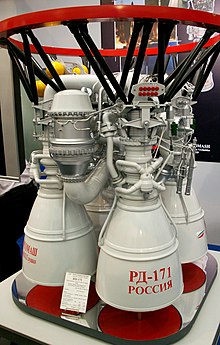

The design of liquid rocket engines enables thrust regulation, long working hours and relatively cheap reuse. For liquid rocket engines, fuel and (unless it is a monergol engine) oxidant are stored outside the engine. They can also be designed to be re-ignitable with little additional effort, so that the engine can have several combustion phases during flight.
The operating materials are often very aggressive chemicals or cold liquefied gases. Both must be stored in special corrosion-resistant or insulated tanks in order to avoid evaporation of the gases or attacking the container wall.
Since the propellants have to be stored and transported, a liquid-propellant rocket is normally much more complicated in its construction than a solid-fuel rocket. The mostly high-energy fuels produce temperatures of up to 4000 Kelvin in the combustion chamber, which requires the use of highly heat-resistant materials and efficient cooling. Oxidant and fuel can be used for cooling. Due to the high pressure under which the gases are in liquid form, various components can be cooled using heat exchangers due to the low temperature.
Fuel extraction
In a liquid rocket engine, the fuel or fuels must be conveyed into the combustion chamber against the pressure prevailing there.
- With the principle of pressurized gas delivery, the tanks are pressurized (mostly with helium or another inert gas.) This limits the combustion chamber pressure and is therefore only suitable for low-power systems, but increases reliability as fewer parts are required.
- The pump delivery permits high pressures and outputs without the entire tank structure having to be designed for the combustion chamber pressure. The greater complexity of these systems is a disadvantage. The pumps can be operated, for example, with auxiliary fuels or directly with the main fuels via a turbine, whereby the following further distinction is made:
Main or secondary flow
In the case of liquid rocket engines with pump delivery, a distinction can be made between main and bypass flow engines:
- With main current engines , all of the propellants are fed through the (main) combustion chamber. The turbines for fuel delivery are driven either by a fuel component heated in the cooling system of the engine ( expander cycle ) or by a working gas generated in a pre-combustion chamber ( staged combustion cycle ).
- In the case of bypass engines, the parts of the propellants used to operate the propellant turbines are not passed through the main combustion chamber. The gas generator cycle represents a design of the bypass engine. Here, to drive the fuel pumps, part of the fuel is burned in a gas generator and the working gas is expanded in a nozzle parallel to the main engine or fed to the main stream in the divergent part of the main nozzle. The topping cycle is another form . Here the fuel flow is divided into two lines. The smaller stream flows through the cooling of the engine, drives the turbines of the fuel pumps and is fed to the main stream in the divergent area of the main nozzle.
Hybrid rocket engine
Both solid and liquid fuel components are used in hybrid rocket engines . The liquid fuel is fed to the solid propellant in a regulated manner, which allows better control over the working speed and duration than with pure solid propulsion units.
Such an engine is used, for example, in SpaceShipOne , a privately developed rocket that, in 2003, was the first private company to take a person into space (to an altitude of over 100 km). The mixture of solid fuel combustion chamber and a simple liquefied gas oxidant ( nitrous oxide ) turned out to be particularly economical.
Control systems
There are a number of ways to influence the thrust vector of a rocket engine:
- Beam deflection (eg. As by thrusters or flaps) at early patterns such as the A4 used
- Pivoting the thrust jet (by panning the engine with combustion chamber) is the most commonly used method
- asymmetrical combustion (e.g. injection of secondary fuel into the thrust jet).
Fuels
There is a wide range of fuels for rocket engines; In chemical fuel systems, a general distinction is made either according to the type of fuel in solid, liquid or hybrid fuels or according to the number of reaction substances involved in the combustion process: monergol (1 chemical), diergol (2 chemicals) or triergol (3 chemicals).
Solar thermal rocket engine
A solar thermal drive, Solar Orbit Transfer Vehicle, SOTV, for changing from LEO to GEO , is in development. Two inflatable parabolic mirrors concentrate the solar radiation on a graphite block through which hydrogen is passed, which is heated to around 2400 Kelvin .
Electric rocket engine
Electric propulsion systems for space travel use electrical energy to generate thrust. Since they only generate a small amount of thrust, they cannot be used for launchers , but have only been used on satellites and probes so far.
The advantages and disadvantages of electric drives are:
- Very high specific impulse possible (exit speed of the fuel).
- Comparably low thrust level can be achieved, so starting from the earth's surface is not possible purely electrically.
- Low thrust leads to precise position control maneuvers, e.g. B. for observation satellites.
- The power is limited by the electrical energy that can be provided by the spacecraft.
- Short-term changes of direction are difficult because of the long burning time with low thrust.
Due to the different types of construction and methods of thrust generation, the electric drives are further differentiated. The division is based on the functional principle into a) electrothermal, b) electrostatic and c) electromagnetic drives. Depending on the type of electrical energy generation, a distinction is still made between solar-electric and nuclear- electric systems.
Electrothermal drive
The (gaseous) fuel is heated with the help of resistance heating or an electric arc and then accelerated with a nozzle. A comparably high thrust can be generated due to the high temperatures, although this is limited by the low mass flow. Gases with a low molar mass , such as. B. hydrogen or ammonia . The efficiency of the electrical energy for heating is relatively low.
Thrusters with resistance heating are called resist jets , those with arc heating are called arc jets .
The achievable thrust of an electrothermal drive is low at a few 100 mN. The outflow speed is typically in the range from 10,000 to 30,000 m / s.
Electromagnetic drive
The fuel or the support mass is heated with the help of resistance heating or an electric arc , as with the electrothermal drive . However, an electromagnetic drive accelerates the generated plasma (≈ 10,000 K) in a magnetic field ( Lorentz force ) instead of with a nozzle.
The achievable thrust of an electromagnetic drive is so far low and is in the mN range. This requires electrical power in the kW range.
The effectiveness of the plasma engines depends on the fuel used. Most fuels with a low molar mass are used, e.g. B. hydrogen, the storage of which is expensive.
Electrostatic drive
In the case of electrostatic thrusters, the thrust is generated by evaporation of the support mass, if it is not already gaseous, ionization of the atoms and acceleration of the ions in an electric field. To avoid electrical charging of the engine, it is necessary to neutralize the support mass behind the acceleration section by adding the electrons removed during the ionization . The thrust per ion and thus the efficiency increases with the mass of the accelerated ions, which is why ion thrusters use the ions of relatively heavy elements. The heavy and expensive noble gas xenon is almost always used today because of its inertia and easy transportability .
The efficiency of these drives is relatively high, as is the discharge speed. However, the achievable thrust forces are very low and are in the mN range.
Nuclear rocket engine
All propulsion systems that are operated with the help of nuclear reactions are summarized under nuclear space propulsion. Nuclear energy can basically be generated by fission or fusion . The power densities that can be achieved in this way are by the factor (nuclear fission) or (nuclear fusion) greater than that of chemical drives. Work is still going on on nuclear fusion, for example at ITER .
To this day, however, only nuclear fission has been technically implemented and mastered, and only drive systems based on it have been developed and tested, for example between 1954 and 1972 at NERVA . In tests, a specific impulse of 825 s was achieved here, in contrast to the 452 s of current liquid fuel engines such as that of the space shuttle .
So far, no nuclear propulsion system has been used for operational use in the sense of a space mission , as it has so far not appeared to be usable for ecological or political reasons.
Even nuclear rocket drives planned and designed for military use did not go beyond the prototype status. The for the planned intercontinental missiles Pluto developed nuclear Ramjet -Triebwerk Tory IIC in 1964 tested for the second and last time. The corresponding project ended on July 1, 1964.
All nuclear drive systems or concepts have in common that the energy generated in the nuclear process is transferred to a support mass and this is relaxed in a nozzle . The only exception to this rule was the concept of nuclear pulse propulsion . Here, atomic bombs were to be detonated outside the spacecraft and the pulse of the plasma hitting the spacecraft should be used for acceleration, see Orion project .
Starting in 2003, NASA started thinking about the Prometheus project again . The aim is a nuclear drive that will enable probe missions to the central planets of the solar system, for example for the JIMO program. The electrical energy generated by nuclear power is to be converted here via an ion drive .
In October 2009, the Russian space agency Roskosmos announced a 1954 began developing a gas nuclear reactor ( Nuclear Reactor Core gas - resume NGCR). The engine uses highly enriched uranium in a plasma gas phase at a pressure of 1000 bar and temperatures of up to 70,000 Kelvin. Hydrogen is to be used as a fuel, supplemented by alkali metals such as lithium to promote the transfer of energy from radiation. The project plan should have been developed by 2012, the development can take 9 years, with a budget of 17 billion rubles (580 million dollars). The engine is supposed to create the conditions for a manned Mars mission .
Cold gas engine
With the cold gas drive, a pressurized gas, usually nitrogen , is released from a pressure vessel via nozzles. Due to the low specific impulse , this drive is mostly used to stabilize the position of small and inexpensive satellites.
Rocket propulsion efficiency
To determine the efficiency, we assume that an energy drives the fuel mass and the remaining vehicle mass (structure, payload, etc.) apart. The kinetic energy is obtained for the speed of interest of the rocket after the propulsion phase
Furthermore, due to conservation of momentum, the following relation to the speed of the fuel applies :
Deployed and dissolved according to the energy of the rocket you get
With the introduction of the mass ratio (initial mass / final mass) and based on the total available energy, one obtains
However, it is assumed that the entire energy is converted into speed in one fell swoop. This cannot be achieved in reality, rather a substantial part of the energy for accelerating the still unburned fuel is lost. One therefore integrates analogously to the procedure for the basic rocket equation and obtains again from the relation to the total energy
The corresponding function shows a clear maximum at a mass ratio of just under 5, but even then only reaches just under 40%.
test
The German Aerospace Center operates the “ European Center for Space Propulsion ” in Lampoldshausen , where, for example, the Vulcain 2.1 main stage engine for Ariane 6 is tested - Europe's most powerful rocket engine to date (as of 10/2018).
See also
Web links
- Overview of rocket engine test rigs at DLR
- Radiofrequency Ion Thruster Heritage: EURECA
- NASA gives “Go” to the Prometheus nuclear project
- Nuclear rocket propulsion at FAS
- DLR: Advanced Rocket Engines
- Tool for the thermodynamic calculation of the performance data of rocket engines
literature
- George P. Sutton, Oscar Biblarz: Rocket Propulsion Elements . 9th edition. John Wiley & Sons , Hoboken 2017, ISBN 978-1-118-75388-0 .
Individual evidence
- ↑ Koroteev, Son: Development Nuclear Gas Core Reactor in Russia ( Memento from September 30, 2007 in the Internet Archive ) (PDF; 91 kB), 45th AIAA Aerospace Sciences Meeting, January 2007
- ↑ dailytech.com: Russia is Developing Nuclear Fission Spaceship to Reach the Red Planet ( Memento from August 20, 2017 in the Internet Archive ), October 29, 2009
- ↑ Spacecraft Propulsion - Chemical ( Memento of October 4, 2015 in the Internet Archive )
- ^ TU Delft: Cold gas systems ( Memento of November 8, 2006 in the Internet Archive )
